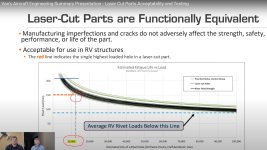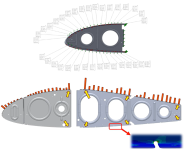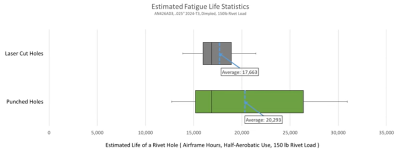The Van’s Aircraft Engineering team has recorded two presentations related to the acceptability, use, and testing results of laser-cut parts in RV aircraft. The videos include an 18-minute summary presentation with an introduction by Dick VanGrunsven, as well as a highly-detailed, 2-hour presentation by the Van’s Engineering team. These presentations have been made to groups of civil aviation authorities as well as a group of kit industry experts.
In short, the results of extensive testing of laser-cut parts manufactured for Van’s Aircraft shows that the parts are safe for use in aircraft construction. Van’s Aircraft worked with a third-party professional company that specializes in fatigue and materials testing in the design and execution of its test program, which included the same tests being run at both companies to validate methodology and results. Van’s has applied a significant engineering margin to the test results, assuming the combined worst-case scenarios in terms of fatigue and aircraft operational usage. Specifically:
- Calculations related to aircraft and part lifetimes were made using worst-case conditions, evaluating dozens of variables.
- Aircraft usage calculations assume that the airplane is flown 30 minutes of each hour at full aerobatic air show loads, and the remaining 30 minutes of each hour at flight-school loads; this represents an effectively impossible use case, but ensures the calculations more than cover any possible realistic use of the aircraft.
Given these extreme calculations, the aircraft’s lifespan is considerably higher than would be expected for an RV aircraft and is considerably longer than any flying RV. When calculating for actual, typical use the lifespan is many multiples greater than for any RV.
If, after viewing the below videos you have questions that have not been answered, please feel free to submit them via the form at the end of the web page on the Van's site. The Van’s Aircraft engineering staff will answer commonly asked questions during January, and we will post some of the more common questions and answers as they are compiled.
Last edited:







